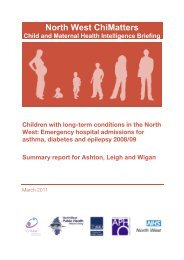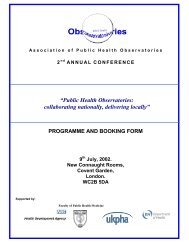9261 HEPATITIS C REPORT GALLEY - North West Public Health ...
9261 HEPATITIS C REPORT GALLEY - North West Public Health ...
9261 HEPATITIS C REPORT GALLEY - North West Public Health ...
Create successful ePaper yourself
Turn your PDF publications into a flip-book with our unique Google optimized e-Paper software.
S UMMARY<br />
Viruses such as HIV, hepatitis C and hepatitis B that are transmitted in the blood pose<br />
a major health threat for people who inject drugs. Hepatitis C is a particular cause for<br />
concern for several reasons. Firstly, its prevalence is extremely high among injecting<br />
drug users (IDUs) (reported levels range between 60 - 80%). Secondly, no vaccine is as<br />
yet available, and the rapid mutation rate of the virus makes the imminent<br />
development of one unlikely. Thirdly, treatment is often ineffective, with even the most<br />
advanced treatment available clearing the infection on only 40% of occasions. Finally,<br />
a high proportion of cases (around 80%) become chronically infected, and of these,<br />
around 20% go on to develop serious liver damage, such as cirrhosis or hepatic<br />
carcinomas. Because individuals can have many years of asymptomatic infection before<br />
presenting to health services with chronic disease, the scale of the problem is hard to<br />
assess. Moreover, in IDUs infection with multiple strains of hepatitis C or co-infection<br />
with hepatitis B or HIV is common, and this exacerbates damage to the liver.<br />
In the wake of the HIV crisis and the provision of needle exchange schemes, IDUs<br />
reduced the levels of high risk sharing behaviour. However, hepatitis C is much more<br />
efficiently transmitted in small amounts of blood, and infections occur via indirect<br />
sharing of other injecting paraphernalia. At present there is no national strategy for<br />
the screening and treatment of IDUs. Treatment requires a high level of compliance,<br />
and has unpleasant side effects such as depression. Since IDUs often display chaotic<br />
behaviour, they are generally not considered suitable for treatment. However, taking a<br />
hepatitis C test and the counselling that accompanies it may represent an opportunity<br />
for addressing risk behaviours and possibly stabilising drug use.<br />
Aims<br />
Reviewing current knowledge about hepatitis C epidemiology reveals a number of<br />
factors that are at present unmeasured but necessary to implement effective and<br />
economic policies for hepatitis C prevention and treatment. Key amongst these is the<br />
level of infection in wider drug injecting communities in the <strong>North</strong> <strong>West</strong> (not just those<br />
requesting a test or in treatment at specialist drug agencies). Equally however,<br />
additional data are needed on the risk behaviours associated with infection and<br />
information is required on whether and how individuals change such behaviour once<br />
aware of their hepatitis C serostatus. Consequently, a group of IDUs in the <strong>North</strong> <strong>West</strong><br />
were recruited in order to:<br />
1. compare the prevalence of hepatitis C among drug users accessing different types<br />
of service, and among drug users not accessing services<br />
2<br />
H EPATITIS C IN INJECTING DRUG USERS IN THE N ORTH W EST











